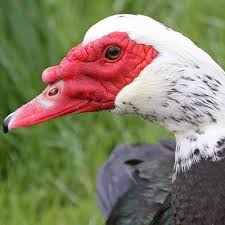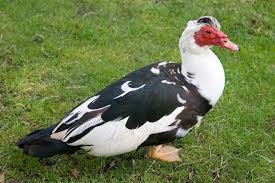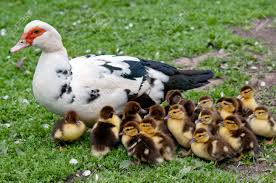The Muscovy duck is a large duck native to Mexico, Central, and South America. Small wild and feral breeding
populations have established themselves in the United States, particularly in Florida and the lower Rio
Grande Valley of Texas as well as in many other parts of North America, including southern Canada. Feral
Muscovy ducks are found in New Zealand, Australia, and in parts of Europe.
They are large ducks, with the males about 76 cm (30 in) long, and weighing up to 7 kg (15 lb). Females are
considerably smaller, and only grow to 3 kg (6.6 lb), roughly half the males' size. The bird is predominantly
black and white, with the back feathers being iridescent and glossy in males, while the females are more
drab. The amount of white on the neck and head is variable, as well as the bill, which can be yellow, pink,
black, or any mixture of these. They may have white patches or bars on the wings, which become more
noticeable during flight. Both sexes have pink or red wattles around the bill, those of the male being
larger and more brightly colored.
Although the Muscovy duck is a tropical bird, it adapts well to cooler climates, thriving in weather as cold
as −12 °C (10 °F) and able to survive even colder conditions. In general, Barbary duck is the term used for
C. moschata in a culinary context.
The domestic breed, Cairina moschata domestica, is commonly known in Spanish as the pato criollo ("creole
duck"). They have been bred since pre-Columbian times by Native Americans and are heavier and less able to
fly long distances than the wild subspecies. Their plumage color is also more variable. Other names for the
domestic breed in Spanish are pato casero ("backyard duck") and pato mudo ("mute duck").
Description
All Muscovy ducks have long claws on their feet and a wide flat tail. In the domestic drake (male), length
is about 86 cm (34 in) and weight is 4.6-6.8 kg (10-15 lb), while the domestic hen (female) is much smaller,
at 64 cm (25 in) in length and 2.7-3.6 kg (6.0-7.9 lb) in weight. Large domesticated males often weigh up to
8 kg (18 lb), and large domesticated females up to 5 kg (11 lb).

The true wild Muscovy duck, from which all domesticated Muscovys originated, is blackish, with large white
wing patches. Length can range from 66 to 84 cm (26 to 33 in), wingspan from 137 to 152 cm (54 to 60 in) and
weight from 1.1-4.1 kg (2.4-9.0 lb) in wild Muscovys. On the head, the wild male has short crest on the nape.
The bill is black with a speckling of pale pink. A blackish or dark red knob can be seen at the bill base,
and the bare skin of the face is similar to that in color. The eyes are yellowish-brown. The legs and webbed
feet are blackish. The wild female is similar in plumage, but is also much smaller, and she has feathered
face and lacks the prominent knob. The juvenile is duller overall, with little or no white on the upperwing.
Domesticated birds may look similar; most are dark brown or black mixed with white, particularly on the
head. Other colors such as lavender or all-white are also seen. Both sexes have a nude black-and-red or
all-red face; the drake also has pronounced caruncles at the base of the bill and a low erectile crest of
feathers.
C. moschata ducklings are mostly yellow with buff-brown markings on the tail and wings. For a while after
hatching, juveniles lack the distinctive wattles associated with adult individuals, and resemble the
offspring of various other ducks such as Mallards. Some domesticated ducklings have a dark head and blue
eyes, others a light brown crown and dark markings on their nape. They are agile and speedy precocial birds.
The drake has a low breathy call, and the hen a quiet trilling coo.
The karyotype of the Muscovy duck is 2n=80, consisting of three pairs of macrochromosomes, 36 pairs of
microchromosomes, and a pair of sex chromosomes. The two largest macrochromosome pairs are submetacentric,
while all other chromosomes are acrocentric or (for the smallest microchromosomes) probably telocentric. The
submetacentric chromosomes and the Z (female) chromosome show rather little constitutive heterochromatin
(C bands), while the W chromosomes are at least two-thirds heterochromatin.
Male Muscovy ducks have spiralled penises which can become erect to 20 cm (7.9 in) in one third of a second.
Females have cloacas that spiral in the opposite direction that appear to have evolved to limit forced
copulation by males.
Behavior
Wild Muscovy Ducks are wary birds that feed by dabbling in shallow wetlands. Domesticated individuals can be
common at urban parks, where they mix with other ducks and take handouts from park visitors.
Habitat
Wild Muscovy Ducks live in forested wetlands and nest in tree cavities. They forage in shallow wetlands,
ponds, and lagoons. Domesticated ducks can be common on farms and in parks.
Reproduction
This species, like the mallard, does not form stable pairs. They will mate on land or in water (note the
submerged female in the image below). Domesticated Muscovy ducks can breed up to three times each year.
The hen lays a clutch of 8-16 white eggs, usually in a tree hole or hollow, which are incubated for 35 days.
The sitting hen will leave the nest once a day from 20 minutes to one and a half hours, and will then
defecate, drink water, eat and sometimes bathe. Once the eggs begin to hatch it may take 24 hours for all
the chicks to break through their shells. When feral chicks are born they usually stay with their mother for
about 10-12 weeks. Their bodies cannot produce all the heat they need, especially in temperate regions, so
they will stay close to the mother especially at night.
Often, the drake will stay in close contact with the brood for several weeks. The male will walk with the
young during their normal travels in search for food, providing protection. Anecdotal evidence from East
Anglia, UK suggests that, in response to different environmental conditions, other adults assist in
protecting chicks and providing warmth at night. It has been suggested that this is in response to local
efforts to cull the eggs, which has led to an atypical distribution of males and females as well as young and
mature birds.
For the first few weeks of their lives, Muscovy ducklings feed on grains, corn, grass, insects, and almost
anything that moves. Their mother instructs them at an early age how to feed.
Domestication
Muscovy ducks had been domesticated by various Native American cultures in the Americas when Columbus arrived
in the Bahamas. The first few were brought onto the Columbus ship Santa Maria they then sailed back to Europe
by the 16th century.
The Muscovy duck has been domesticated for centuries, and is widely traded as "Barbary duck". Muscovy breeds
are popular because they have stronger-tasting meat-sometimes compared to roasted beef-than the usual
domestic ducks which are descendants of the mallard (Anas platyrhynchos). The meat is lean when compared to
the fatty meat of mallard-derived ducks, its leanness and tenderness being often compared to veal. Muscovy
ducks are also less noisy, and sometimes marketed as a "quackless" duck; even though they are not
completely silent, they don't actually quack (except in cases of extreme stress). The carcass of a Muscovy
duck is also much heavier than most other domestic ducks, which makes it ideal for the dinner table.
Domesticated Muscovy ducks, like those pictured, often have plumage features differing from other wild birds.
White breeds are preferred for meat production, as darker ones can have much melanin in the skin, which some
people find unappealing.
The Muscovy duck can be crossed with mallards in captivity to produce hybrids, known as mulard duck
("mule duck") because they are sterile. Muscovy drakes are commercially crossed with mallard-derived hens
either naturally or by artificial insemination. The 40-60% of eggs that are fertile result in birds raised
only for their meat or for production of foie gras: they grow fast like mallard-derived breeds but to a large
size like Muscovy ducks. Conversely, though crossing Mallard drakes with Muscovy hens is possible, the
offspring are neither desirable for meat nor for egg production.
In addition, Muscovy ducks are reportedly cross-bred in Israel with Mallards to produce kosher duck products.
The kashrut status of the Muscovy duck has been a matter of rabbinic discussion for over 150 years.
Oscillococcinum is a homeopathic preparation made from Muscovy duck liver and heart manufactured by the
French company Boiron; similar products are also available from other manufacturers. Typically diluted with
lactose and sucrose to 1:10400 (far less than one in one googol), they are advertised to relieve
influenza-like symptoms, but no evidence has been found of its efficacy.
A study examining birds in northwestern Colombia for blood parasites found the Muscovy duck to be more
frequently infected with Haemoproteus and malaria (Plasmodium) parasites than chickens, domestic pigeons and
domestic turkeys. and in fact almost all wild bird species studied also. It was noted that in other parts of
the world, chickens were more susceptible to such infections than in the study area, but it may well be that
Muscovy ducks are generally more often infected with such parasites (which might not cause pronounced
disease though, and are harmless to humans).








